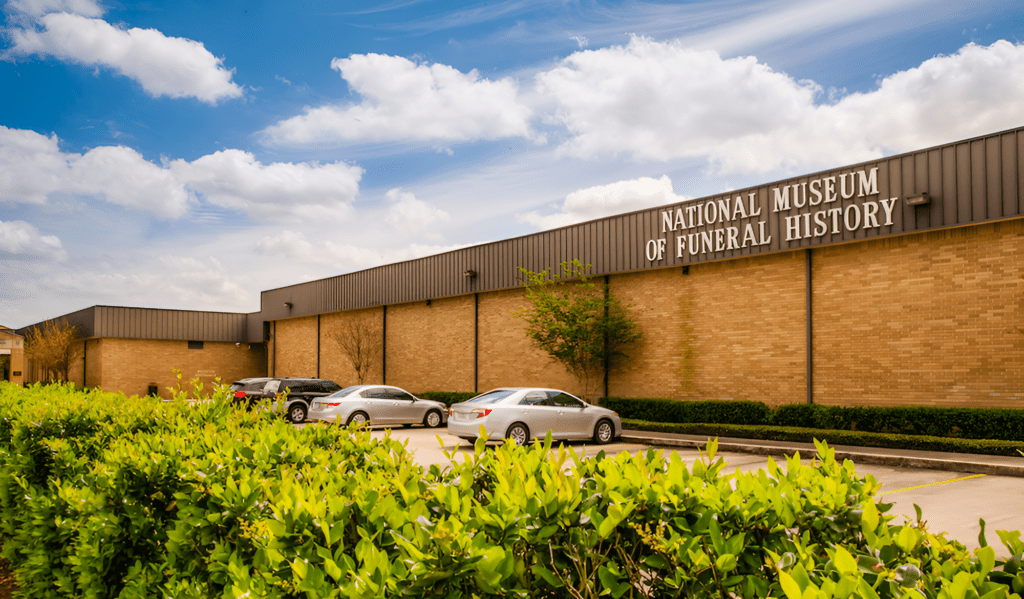The National Museum of Funeral History in Houston, Texas Visiting the museum is an integral part of finding out more about the funeral and death customs history. The display showcases the value and virtue of funerary traditions while also highlighting cultural and historical memorial practices across societies.
History of the Museum
Founded by Houston funeral home magnate Robert L. Waltrip, the National Museum of Funeral History opened its doors in 1992. The vision has always been to provide an educational platform for people curious about the changing funeral industry. Over the years, the museum has grown and has created new exhibitions and collections as well. It is an endeavor being made to break the taboo around death and to respect the rituals associated with it.
Layout and the Architecture of the Museum
The museum is 30,000 square feet in size, one of the largest in the world. It is composed of several galleries, each one dedicated to a different part of funeral history. It is easy for visitors to navigate through the building with its sprawling hallways and a combination of historical and present-day exhibits. The display cases are perfectly presented in chronological order with excellent descriptions for each one, so navigation was easy.
Exhibits that Span Time and Cultures
The museum has 16 permanent exhibits in every area of funerary history. The museum actively showcases the historical practices of ancient Egyptian burial and embalming, demonstrating how these traditions have influenced African American funeral services in New Orleans.
One of its most memorable exhibitions, co-commissioned in collaboration with the Vatican, was Celebrating The Lives and Deaths of Popes, which traces centuries’ worth of ceremonial pomp surrounding papal funerals. Also on display is an actual mercy casket used to embalm Pope John Paul II. This immersive recreation displays replicas of the papal casket and items used in these grand events, bringing visitors to what it must have felt like at that moment. Customs from around the globe and throughout history come together, transforming into what feels like a humanizing global museum.
Presidential and Celebrity Memorials
An abundance of rare presidential memorabilia is displayed in the Presidential Funeral Gallery at NMFH, including one-of-a-kind artifacts such as George Washington’s funeral bill and Abraham Lincoln’s hair strands alongside Ronald Reagan’s hearse. These relics give us a real sense of presence with historical figures and demonstrate the nation’s grief toward their leaders. ·
Also, the Thanks for the Memories exhibit that honors celebrities who have passed away, like Whitney Huston and Michael Jackson, displays mementos from their funerals.
Exploring Funeral Customs Worldwide
This museum appreciates exhibits of many kinds from the world over. This includes fantasy coffins from Ghana, modeled after bright forms like fish or airplanes that delineate specific funeral ceremonies. For example, The History of Cremation is an exhibit that explores the history and development surrounding cremation practices from forever ago to modern inroads with new mortician technology.
Interactive Experiences and “Selfie” Spots
For those who are eager for a more hands-on experience, NMFH has interactive displays allowing visitors to immerse themselves in the many facets of funeral history. During the late 1800s, mourning photography emerged, especially in Victorian times, as people commonly took photos of deceased loved ones. The exhibition becomes spectacular with selfie stations, themed categories, and posing spots featuring era artifacts.
Effects on the Community and Education Programs
The museum also offers educational programs, including guided tours on embalming instruments and hearses. The museum has transformed from a place once seen as “morbid” into a respected cultural institution, allowing people to learn about and embrace death care practices.
New Arrivals & Current Special Exhibits
The museum collection now includes modern funeral protocols and explores the impact of technology on this industry. Additionally, a seasonal “Day of the Dead” exhibit celebrates the vibrant Mexican holiday honoring the deceased. This colorful display contrasts with the darker traditions featured in the museum, highlighting the diverse global experiences of funeral customs.
Visitor Information
The National Museum of Funeral History is now more accessible to a broader audience, opening its doors daily: Monday through Friday from 10:00 AM to 4:00 PM, Saturday from 10:00 AM to 5:00 PM, and Sunday from noon to 5:00 PM.
Ticket Information
Single-entry prices are $10 for adults, $9 for older people(+55), $7 for military/veteran discounts, and just $5 per student with an ID. With a paying adult, children ages six and under get free admission. Group discounts are available, as well as school field trip pricing from museums and memorials.
Update
The museum is enhancing traditional memorials with new touch-screen kiosks, where visitors can now experience virtual reality funerals, view online memorial pages, and hear tributes like, “Proceed with the groundbreaking… thus lies Hugh Hefner… and his chipmunk dressed for eternity.”
The museum is also holding an array of events surrounding its forthcoming anniversary, like lectures and thematic tours. This will help visitors understand the evolving history of funeral practices leading up to contemporary times.
Visitor Experience & Amenities
The museum offers a self-guided cultural tour featuring detailed plaques and audio guides in various languages. Additionally, visitors can shop for unique books, collectibles, and exhibition-inspired items in the museum’s gift shop. On-site parking is free, and the museum is wheelchair accessible.

